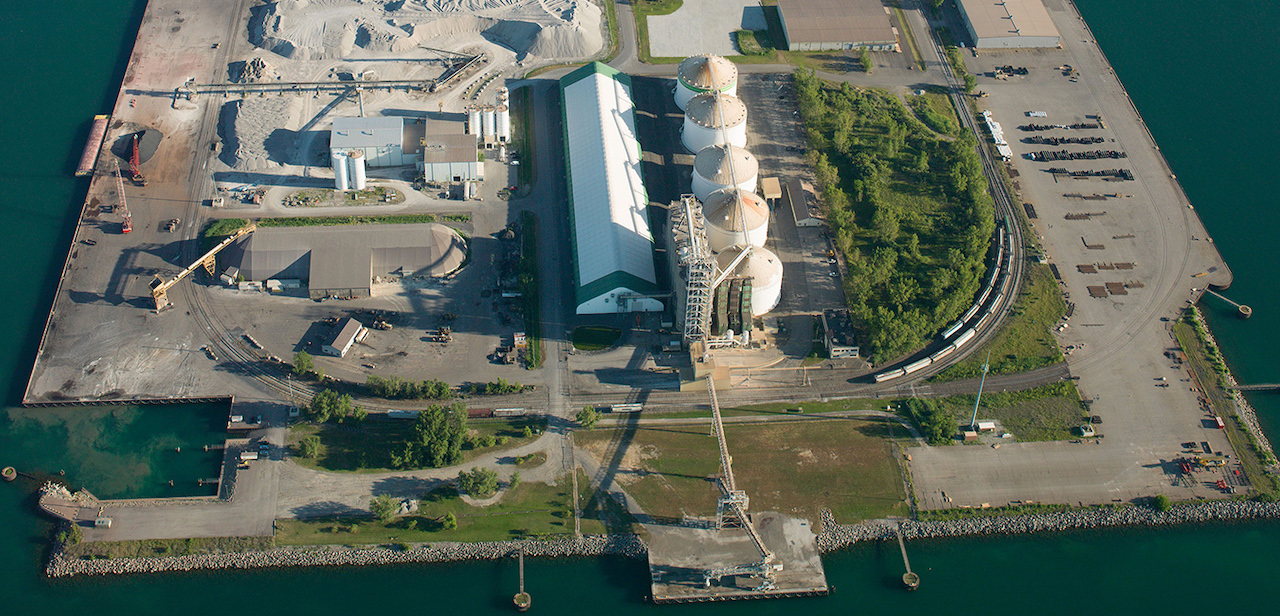
Intermodal Briefs: Ports of Indiana, PANYNJ
Written by Carolina Worrell, Senior Editor
Ports of Indiana issues Request for Qualifications (RFQ) for new operator of International Ag Shipping Terminal on Lake Michigan. Also, the Port Authority of New York and New Jersey (PANYNJ) regains top spot as busiest port in nation.
Ports of Indiana on March 29 issued an RFQ to identify potential operators of the International Ag Shipping Terminal at Ports of Indiana-Burns Harbor. This the first time the seven-million-bushel Lake Michigan terminal, which has transload capabilities for ocean ships, lake vessels, rive barges, unit trains and trucks, is available for a new operator in 44 years.
The RFQ seeks qualifications from companies interested in operating the ag terminal. Responses are due April 21. Ports of Indiana will issue a formal Request for Proposals (RFP) in May to all qualified companies.
According to Ports of Indiana, the facility has been operated by Cargill since 1979 but the company announced it is changing its business model in the region and will relinquish the facility to the port as of June 1. Ports of Indiana originally financed the construction of Cargill’s facility in 1979 and, through the years, the terminal has exported more than 500 million bushels of corn and soybeans to world markets. The terminal can handle ocean vessels transiting the Great Lakes, 1,000-foot lake vessels, year-round barge traffic via the inland river system and unit trains from nearly all Class I railroads.
The grain elevator terminal includes 7.2 million bushels of storage facilities and high-speed loading capacities that can load 90,000 bushels per hour into an ocean vessel and unload 30,000 bushels per hour from a unit train, which are “industry leading capacities even today,” according to the port. Ports of Indiana will assume possession of the facility and is currently looking for a long-term partner to help grow shipments at the port.
“It’s the end of an era and a new beginning for one of the largest international ag terminals on the Great Lakes,” said Ports of Indiana-Burns Harbor Port Director Ryan McCoy. “It’s bittersweet for me because I worked at that facility for 10 years and Cargill has been a great partner for the Ports of Indiana and the local community. However, this change also creates a unique opportunity to reimagine the facility and expand its capabilities going forward.”
“We’re excited about the next chapter for this terminal,” McCoy added. “We have received multiple inquiries from companies interested in expanding the facility. This is a unique deep-water terminal with tremendous capabilities for shipping grain, DDGs and many bulk cargoes to and from ocean vessels at the Heartland of America. It’s not every day that this type of facility becomes available.”
The Burns Harbor port opened in 1970, is home to more than 30 companies, and handles approximately three million tons of cargo per year. Currently, the port is developing a $32 million facilities expansion funded by two federal grants that includes construction of two rail yards, new bulk and general cargo terminals, a bulk warehouse, and a truck marshalling yard. The port complex contributes $5.2 billion per year to the Indiana economy and supports more than 30,000 jobs.
PANYNJ announced April 3 that, despite it being the slowest time of year for all U.S. ports due to overseas production slowdowns and closures related to the Lunar New Year holiday, the Port of New York and New Jersey moved 571,177 twenty-foot equivalent units (TEUs) in February 2023, the highest amount of cargo among peer ports, exceeding the Port of Los Angeles by more than 83,000 TEUs and exceeding the Port of Long Beach by more than 27,000 TEUs. The container port’s status as the busiest in the U.S. comes after the seaport was the second busiest in the month of January, when the port moved 645,430 TEUs.
For the first two months of 2023, according to PANYNJ, the port also was the busiest in the nation after moving a total of 1,216,607 TEUs. In particular, the port has been aggressively clearing out its empty container inventory with the removal of more than 390,000 TEUs so far this year. This evacuation of empty containers, PANYNJ says, “helps improve seaport operations and fluidity by ensuring more container terminal space for imports to be processed quickly at the port in the future.”
The Port of New York and New Jersey was previously the busiest container port in the nation for four months from August through November 2022. In 2022, the port handled a total of nearly 9.5 million TEUs, its highest annual amount of cargo in its history.
“The Port of New York and New Jersey is again No. 1 in the nation,” said Port Authority Chairman Kevin O’Toole. “After years of unprecedented cargo growth, we are using this traditionally slow period to work with our port stakeholders who need to increase capacity throughout the regional supply chain. We expect a stronger second half of the year, as we have been in discussions with many importers that shifted volume to us from elsewhere and are now committed to keeping that volume in our gateway.”
“The Port of New York and New Jersey’s return to the top spot as the nation’s busiest demonstrates the port’s continued reliability and consistency as other ports experienced uncertainty and challenges recently,” said Port Authority Executive Director Rick Cotton. “Shippers and retailers know they can rely on the Port of New York and New Jersey to move their cargo quickly month-in and month-out, and that trust is a result of our deep relationships and collaboration with all links in the regional supply chain.”



![“This record growth [in fiscal year 2024’s third quarter] is a direct result of our innovative logistic solutions during supply chain disruptions as shippers focus on diversifying their trade lanes,” Port NOLA President and CEO and New Orleans Public Belt (NOPB) CEO Brandy D. Christian said during a May 2 announcement (Port NOLA Photograph)](https://www.railwayage.com/wp-content/uploads/2024/05/portnola-315x168.png)